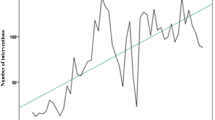Abstract
Urolithiasis is the third most common pathological disease afflicting the urinary tract, and usually occurs between the third and fourth decades of an individual’s life. Epidemiological studies about this condition are lacking in our country. In 1998, we performed an epidemiological, cross-sectional study of the prevalence of urolithiasis in a sample of 1,086 subjects, which included men and women of all ages, selected from the general population of the city of Buenos Aires. The method used to gather basic information was an auto administered questionnaire about the present or past history of urolithiasis that was handled at the dwelling by a trained volunteer. We found a 3.96% lifetime prevalence of urolithiasis in the general population of Buenos Aires. The rate was slightly higher in men (4.35%) than in women (3.62%), with a male to female ratio of 1.19:1. No case of urolithiasis was found in subjects under the age of 20. In subjects over 19 years, the prevalence rate of the disease was 5.14%; 5.98% for men (CI 3.41–8.55%) and 4.49% for women (CI 2.61–6.37%). Prevalence increased with age, ranging from 2.75% in the 20–39 age group to 7.79% in those ≥60 years. The life time prevalence rate of urolithiasis observed in Buenos Aires is similar to that reported in a few other studies performed among males and females in the general population of USA and Europe. Prevalence of urolithiasis increases with age both in men and in women.
Similar content being viewed by others
References
Smith LH (1989) The medical aspects of urolithiasis: an overview. J Urol 141:707
Consensus Conference (1988) Prevention and treatment of kidney stones. JAMA 260:977
Hiatt RA, Dales LG, Friedman GD, Hunkeler EM (1982) Frequency of urolithiasis in a prepaid medical care program. Am J Epidemiol 115:255
Johnson CM, Wilson DM, O’Fallon WM, Malek RS, Kurland LT (1979) Renal stone epidemiology: a 25-year study in Rochester, Minnesota. Kidney Int 16:624
Borghi L, Ferretti PP, Elia GF, Amato F, Melloni E, Trapassi MR, Novarini A (1990) Epidemiological study of urinary tract stones in a Northern Italian City. Br J Urol 65:231
Ljunhall S, Hedstrand H (1975) Epidemiology of renal stones in a middle-aged male population. Acta Med Scan 197:439
Andersen DA (1972) Environmental factors in the etiology of urolithiasis. In: Cifuentes DL, Rapado A, Hodgkinson A (eds) Urinary calculi. Karger, Basel, p 130
Pyrah LN (1979) Epidemiology of urolithiasis, in renal calculus. Springer, Berlin Heidelberg New York, p 3
Serio A, Fraioli A (1999) Epidemiology of nephrolithiasis. Nephron 81(suppl 1):26
Vahlensieck EW, Bach D, Hesse A (1982) Incidence, prevalence and mortality of urolithiasis in the german federal republic. Urol Res 10:161
Stamatelou KK, Francis ME, Jones CA, Nyberg LM, Curhan GC (2003) Time trends in reported prevalence of kidney stones in the United States: 1976–1994. Kidney Int 63:1817
Trinchieri A, Coppi F, Montanari E, Del Nero A, Zanetti G, Pisani E (2000) Increase in the prevalence of symptomatic upper urinary tract stones during de last ten years. Eur Urol 37:23–25
Instituto Nacional de Estadística y Censos (INDEC) (1991) Censo Nacional de Población y Vivienda. Buenos Aires, Argentina
Dos Ramos Farías E, Pinduli I, Man Z, Spivacow R, Toblli J, Vidal S, Licciardi L (1996) Consejo de Litiasis Renal (ANCBA). Sondeo de Prevalencia de la litiasis renal en la región metropolitana, República Argentina, 1995. Anales X Congreso Argentino de Nefrología, San Carlos de Bariloche, p 28
Fleiss JL (1981) Statistical methods for rates and proportions. Wiley, New York, p 14
del Valle E, Spivacow R, Zanchetta JR (1999) Metabolic abnormalities in 2,612 patients with nephrolithiasis. Medicina (Buenos Aires) 59:417–422
Soucie JM, Thon MJ, Coates RJ, McClellan W, Austin H (1994) Demographic and geographic variability of kidney stones in the United States. Kidney Int 46:893
Robertson WG, Peacock M, Baker M, Marshal DH, Pearlman B, Speed R, Sergeant V, Spith A (1984) Epidemiological studies on the prevalence of urinary stone disease in Leeds. In: Ryall RL et al (eds) Urinary stone. Churchill and Livingston, Melbourne, p 6
Acknowledgement
This work was partially supported by Casasco Laboratories, Buenos Aires, Argentina.
Author information
Authors and Affiliations
Corresponding author
Additional information
Héctor J. Boffi-Boggero: Deceased
Rights and permissions
About this article
Cite this article
Pinduli, I., Spivacow, R., del Valle, E. et al. Prevalence of urolithiasis in the autonomous city of Buenos Aires, Argentina. Urol Res 34, 8–11 (2006). https://doi.org/10.1007/s00240-005-0003-7
Received:
Accepted:
Published:
Issue Date:
DOI: https://doi.org/10.1007/s00240-005-0003-7




